Reader's Choice
Popular articles
The main purpose of the pattern is to decorate the thing on which this element is applied. There is little information about the origin of the art of ornamentalism, since its use began many centuries before our era. Ornaments of different nations of the world differ in their individual perception of objects and the environment. Different ethnoses have the same symbols in different ways.
Decoration - this is one of the first But, despite the long history, it is an excellent decor for many modern things.
The ornaments of the peoples of the world are divided into four main groups. It:
Ornaments of the peoples of the world include the following motives:
The original meaning of the Belarusian ornament was ceremonial. Among the main features of ancient patterns are:
The set is explained by the personification of the forces of nature and the surrounding world, which were guarded by man. Ornaments of the peoples of the world, though different from each other, are used for the same purposes: decorating clothes, household items, dwellings, and tools. The number of repetitions of points, triangles, diamonds explain the structure of society. The number three is the Divine Trinity or the sky, the earth and the underworld, four are the seasons, five are sacred, etc.
The Belarusian ornament contains a large number of crosses, which symbolize the image of the sun, fire and justice.
On the tools of labor depicted symbols of fertility, the image of the mother in the form of seed or sprouts meant a good harvest and wealth.
In most ceremonies used towels with ornaments. They were made by combining a white-gray pattern and various geometric motifs. Of great importance is the color of the pattern: white is a symbol of purity and light, red is wealth and energy, black is the speed of the flow of human existence.
Geometrical ornament belongs to the early forms of fine art of Egypt. It shows various objects of the environment in the form of intersection of lines and abstraction.
The main motives include:
The main designation is that personifies the divine power of nature, moral purity, chastity, health, revival and the sun.
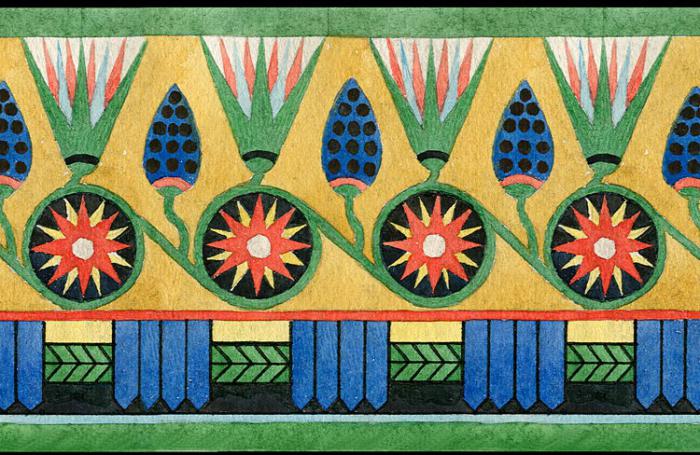 To describe the life of the underworld used a pattern in the form of aloe. Many plants, such as blackthorn, acacia, coconut palm, were the basis for the image in the ornamental art of Egypt.
To describe the life of the underworld used a pattern in the form of aloe. Many plants, such as blackthorn, acacia, coconut palm, were the basis for the image in the ornamental art of Egypt.
Among the geometric lines should be highlighted:
The main characteristics of the ornament in Egyptian culture are restraint, rigor and sophistication.
The Norwegian pattern fully describes the climatic conditions of the country. A large number of snowflakes, drops, deer is used to apply on warm clothes. The geometry of the lines creates amazing patterns inherent only in this nation. 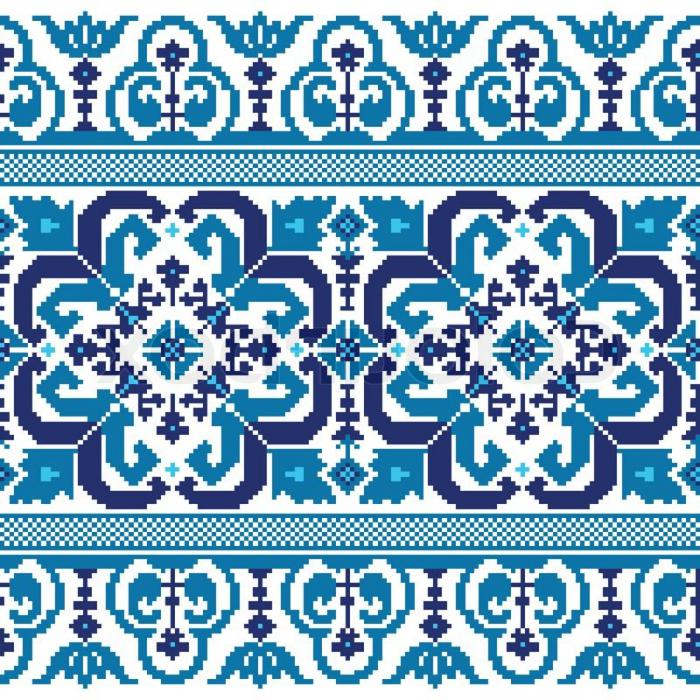
With amazing patterns known all over the world. In ancient Persia, this was the most expensive family value. The canvases were inherited through the generations and were cherished. Ornamentalism is characterized by the predominance of blue and green colors, the image of various birds, animals, including those made up, stripes in the form of a rhomboid fish, pears in the form of a drop.
The basis for the formation of a culture of ornamentalism in ancient Greece was the meander. The endless repetition of patterns symbolizes eternity and infinity of human life. Ancient Greek platings are distinguished by a broad depiction of subjects and diversity. The characteristic features of this culture are the decoration with ornaments with wavy and broken lines of vases and dishes.
The ornament of India is characterized by geometric and spiral forms, it is expressed in the form of a spiral, zigzag, rhombus, triangle. From animalistics used muzzle cats and birds. 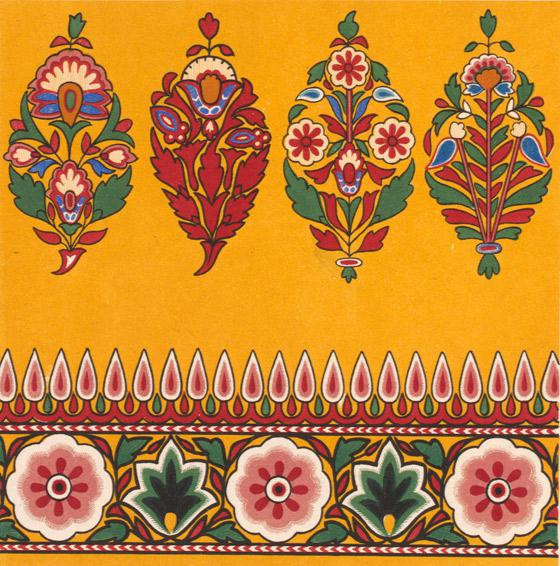
Many ornaments in India are applied to the body with henna. This is a special procedure, it means spiritual cleansing. Each tattoo has a certain meaning.
The usual triangle symbolizes male activity, inverted - female mercy. The meaning of divinity and hope lies in the star.
For the image of protection, reliability and stability using a square or octagon.
Popular ornaments are made up of flowers, fruits and plants; they represent joy, happiness, hope, wealth and health.
Chinese ornaments are easily distinguished from others, they contain large and lush flowers, which are connected by nondescript stalks.
Wood carving represents the ornament of Australia. Of them emit:
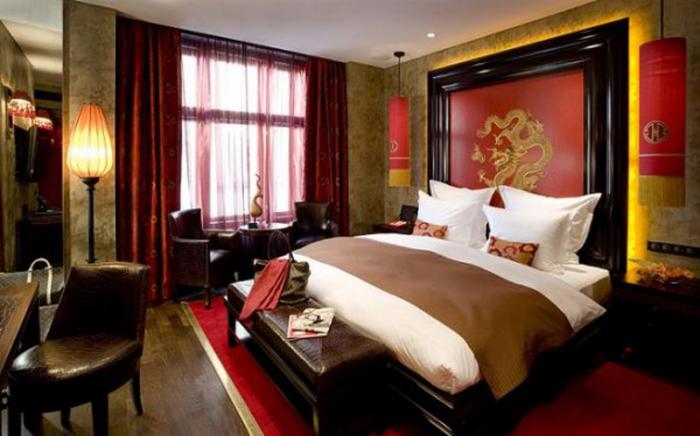
Patterns of Mongolia are presented in the form of a circle, which embodies the rotation of the sun and the sky. For drawing on clothing using geometric shapes, which are called hammer patterns.
The main motives:
The ornaments of the peoples of the world are distinguished by a variety of forms, they reflect the individuality of cultures and the perception of the external world.
One of the newest fashion trends in the world of nail art - nails decorated with ethnic patterns, the so-called tribal nail-art. Last year he was in pastel shades and nuances. This year, choose bright, summer, energetic and colorful colors of lacquers, such as yellow, orange, red, turquoise, and, of course, you will need a basic color - black to create the pattern itself.
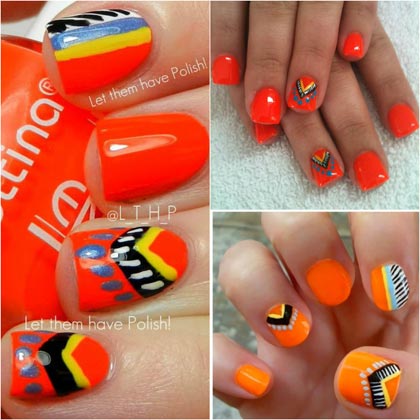
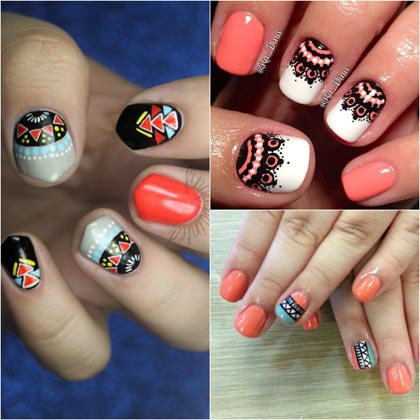
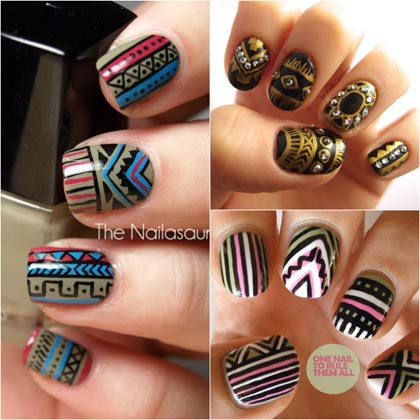
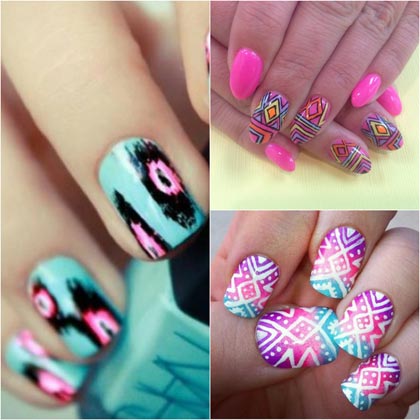
Graphic design includes combinations of lines, circles, points, zigzags and other geometric shapes. The outlines of the figures can be made not only in black, but also in any other.
These drawings are expressive and interesting, and, as always, depending on what you like, you can choose any tendency: keep the manicure simple and neutral or take bold summer colors and shapes!

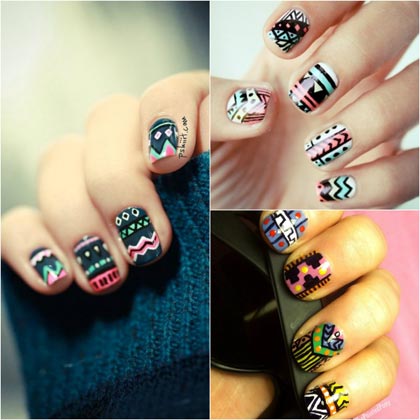
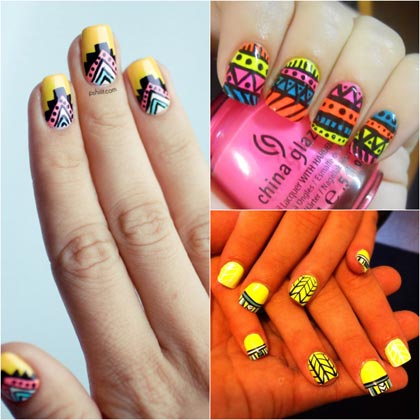

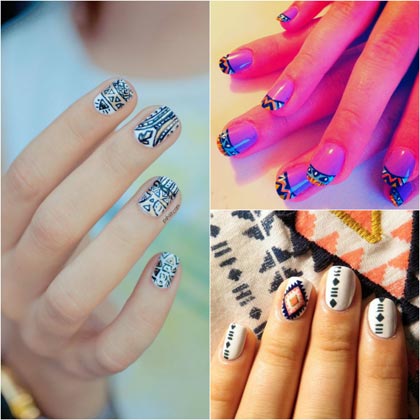
Tribal, usually an angular pattern with a black outline, it is similar to the ethnic symbolic tattoos of Polynesian tribes.
We saw a tribal print on clothes, he found a place among jewelry, now we can have it on our nails. The best in nail design with ethnic patterns is that you can combine and combine geometric shapes at your discretion. There is no doubt that the creation of such a detailed manicure will take you some of the time, this is quite a hard work.
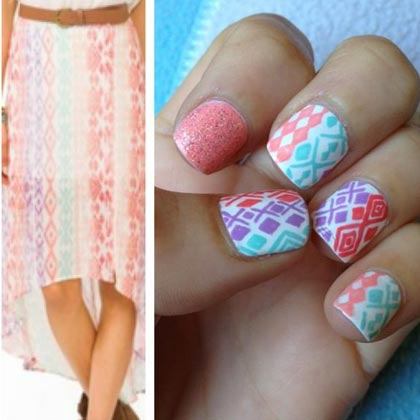


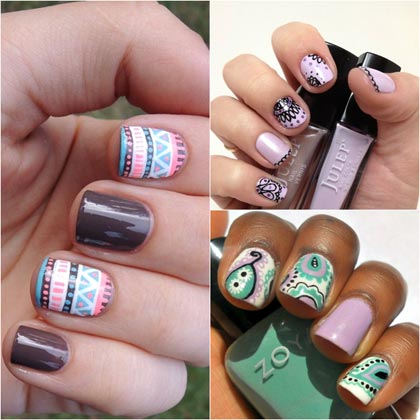
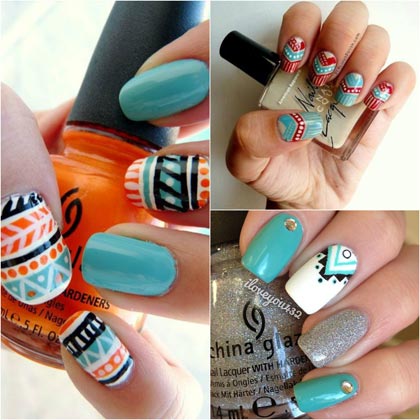
There is so much room for creativity in the Tribal Nail Art. Regardless of whether you want to create your own design or prefer the work of a professional master, the key to a beautiful image is the right choice of a pattern or stencil that will complement your natural style.
For those who love extravagance, choose large, bright and strong ethnic prints. Fans of minimalism pattern can be performed only on the ring finger.

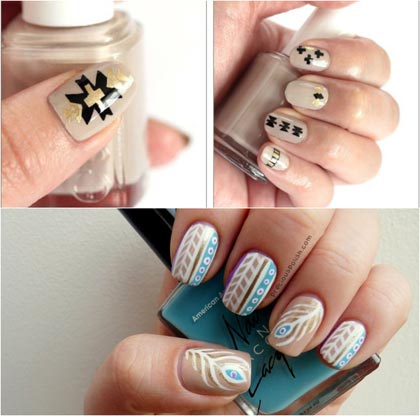

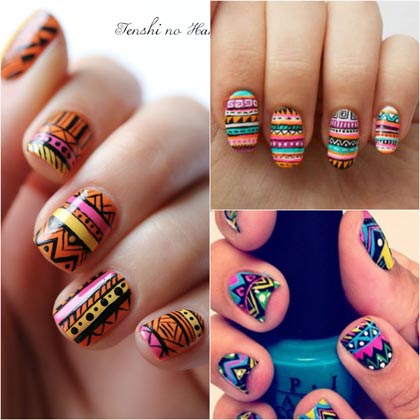
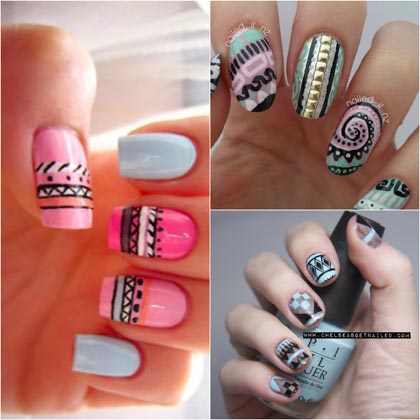
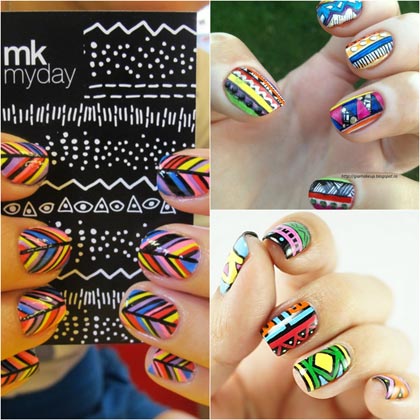
Play with ethnic motifs, changing patterns on each nail. It is best to design in similar shades to observe a uniform style.
Tribal is beautiful, the original design is trendy, besides, it is easy to make with your own hands, the nail art is in perfect harmony with summer clothes.
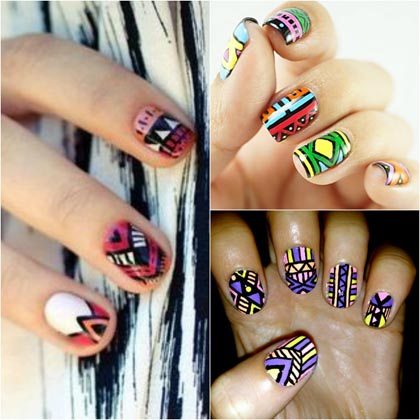

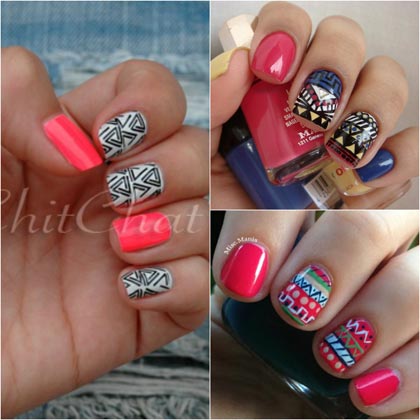

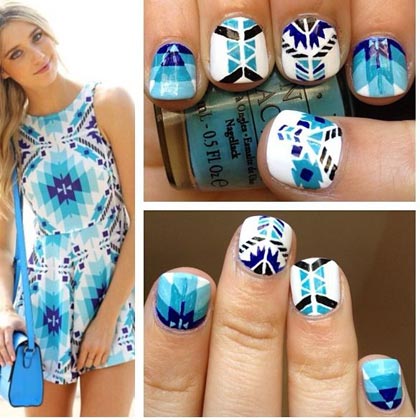
Tip: Use the table! Do not do nail art on the bed, on weight, perhaps, the varnish will be spilled on the bed or even on your favorite laptop. Moreover, on a stable and flat surface it is much more convenient to draw, the lines are smoother.
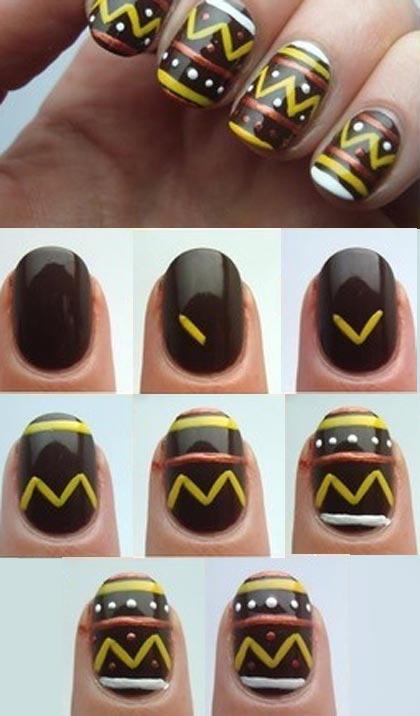

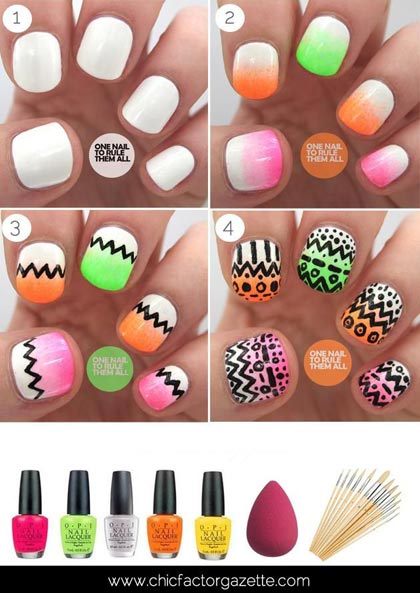
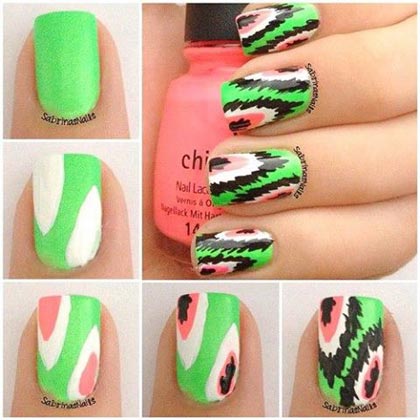

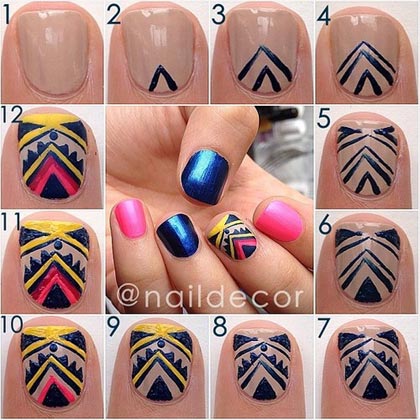
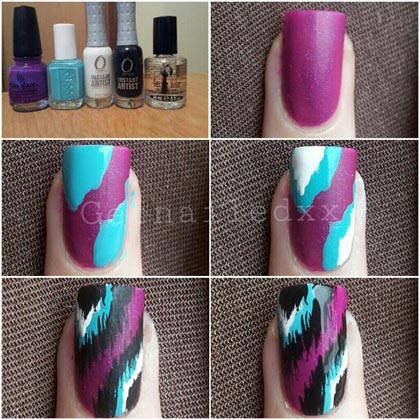
Ethnic motifs in embroidery
Perhaps the only trend in fashion that has absorbed such a variety of shapes, colors, silhouettes and variants of models. And this is not surprising. This style combines all the diversity of elements of national costumes from around the world. The originality of the wardrobe items of individual nations is gathered together, incredible interlacing and mixing in this direction has been created.
The true passes through time with success and does not lose its relevance. His motifs are used in interior design, clothing, jewelry.
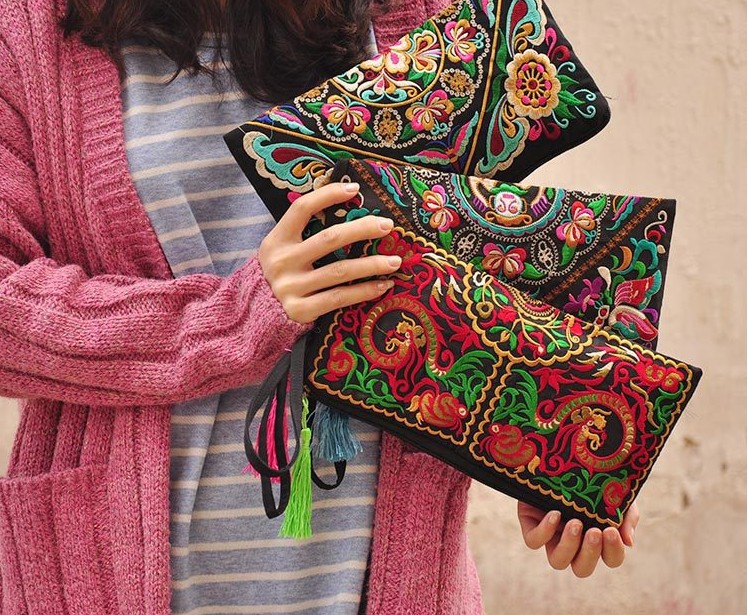
Ladies elegant retro handbag with ethnic embroidery handmade
The secret lies in the symbolism, wisdom and truthfulness of the style, since all the patterns and ornaments in the ethnic style are a centuries-old heritage of folk traditions.

Kazakhstan artistic ethnic embroidery
Handicrafts in ethno style reflect the culture, life, traditions of our ancestors. It finds its manifestation in folklore, cuisine, clothing, and even medicine.
![]()
Embroidery is the most common and developed form of folk art, it vividly and many-sidedly reflects the artistic culture of the people.
Patterns, embroidery, weaving, like an ancient mirror, are a reflection of the soul of any nation that still inhabits or has already disappeared from the face of our planet.
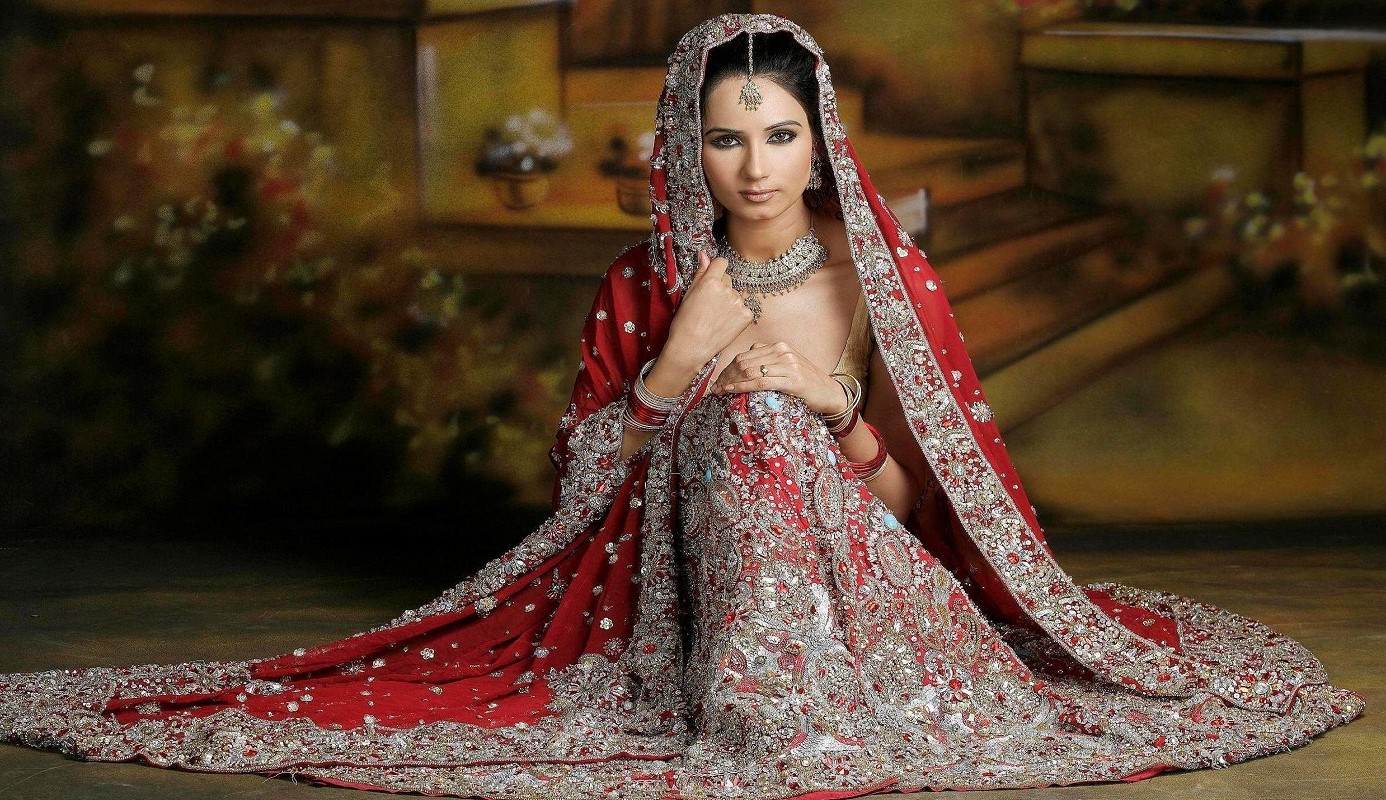
Indian sari - national women's clothing, which is always decorated with rich embroidery and is still one of the symbols of India.
Ethnic style is a whole culture, which is focused on the preservation of the ancient traditions of its people and the deep reverence of their ancestors.
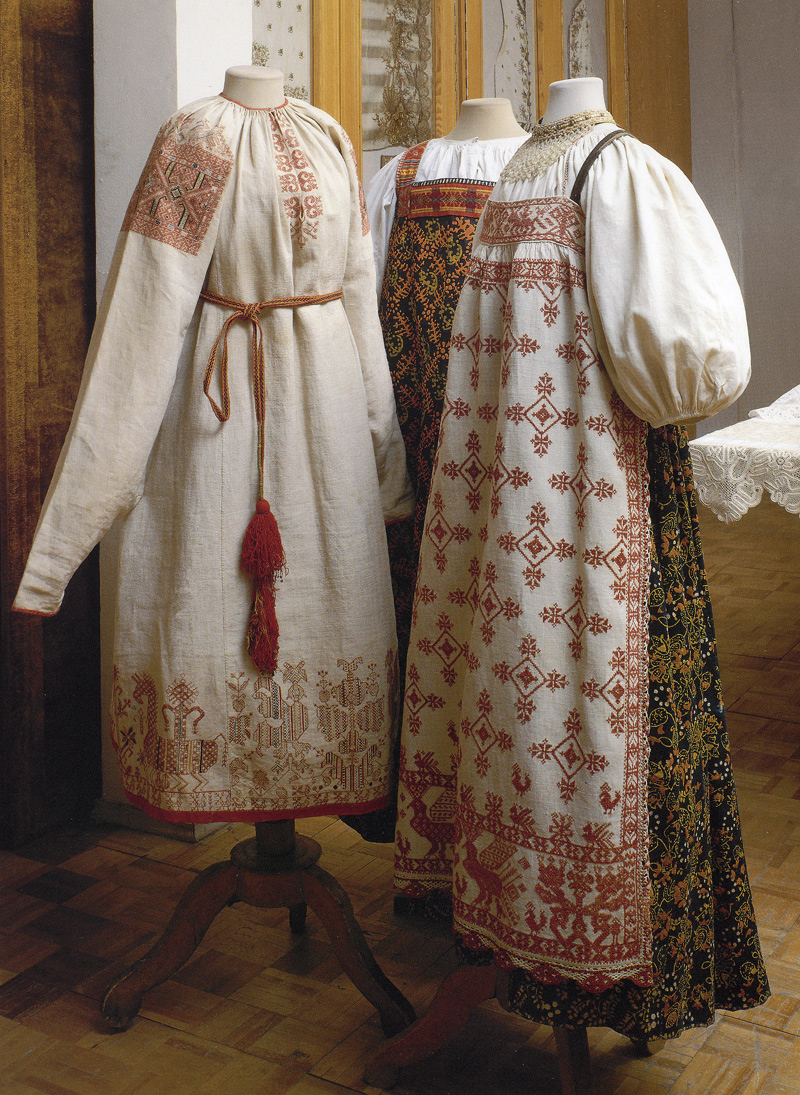
Russian folk clothes - the keeper of the original folk culture, wealth of the people, the chronicle of folk customs
Today, these traditions can manifest themselves in different ways. For example, the British eat oatmeal for breakfast, the Scots wear a kilt (men's plaid skirt), the Ukrainians "holy" wear.
Each nation has its own individual expression of its culture. But absolutely everyone has their own distinctive ornaments, symbols and patterns.

Geometric images - squares, rhombuses, triangles - are widespread in the art of ancient Egypt
It is not only about traditional Slavic embroidery and weaving. Indians, African tribes, Celts - all have their own authentic culture, which has come down in the form of schemes and symbols to the present day.
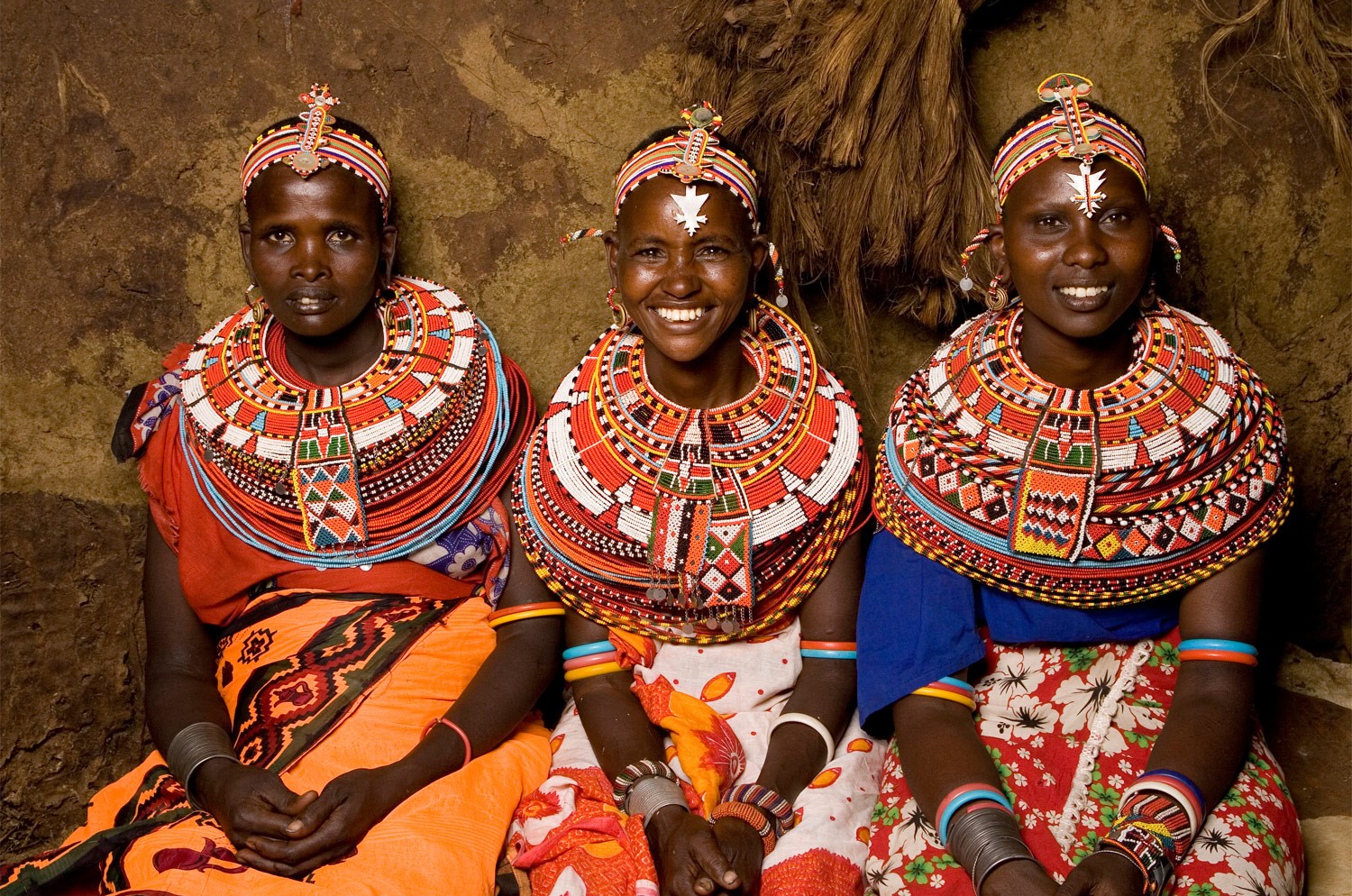
Africa - rich colors and a variety of patterns that are very pleasing to the eye
Especially popular today is the art of embroidery.
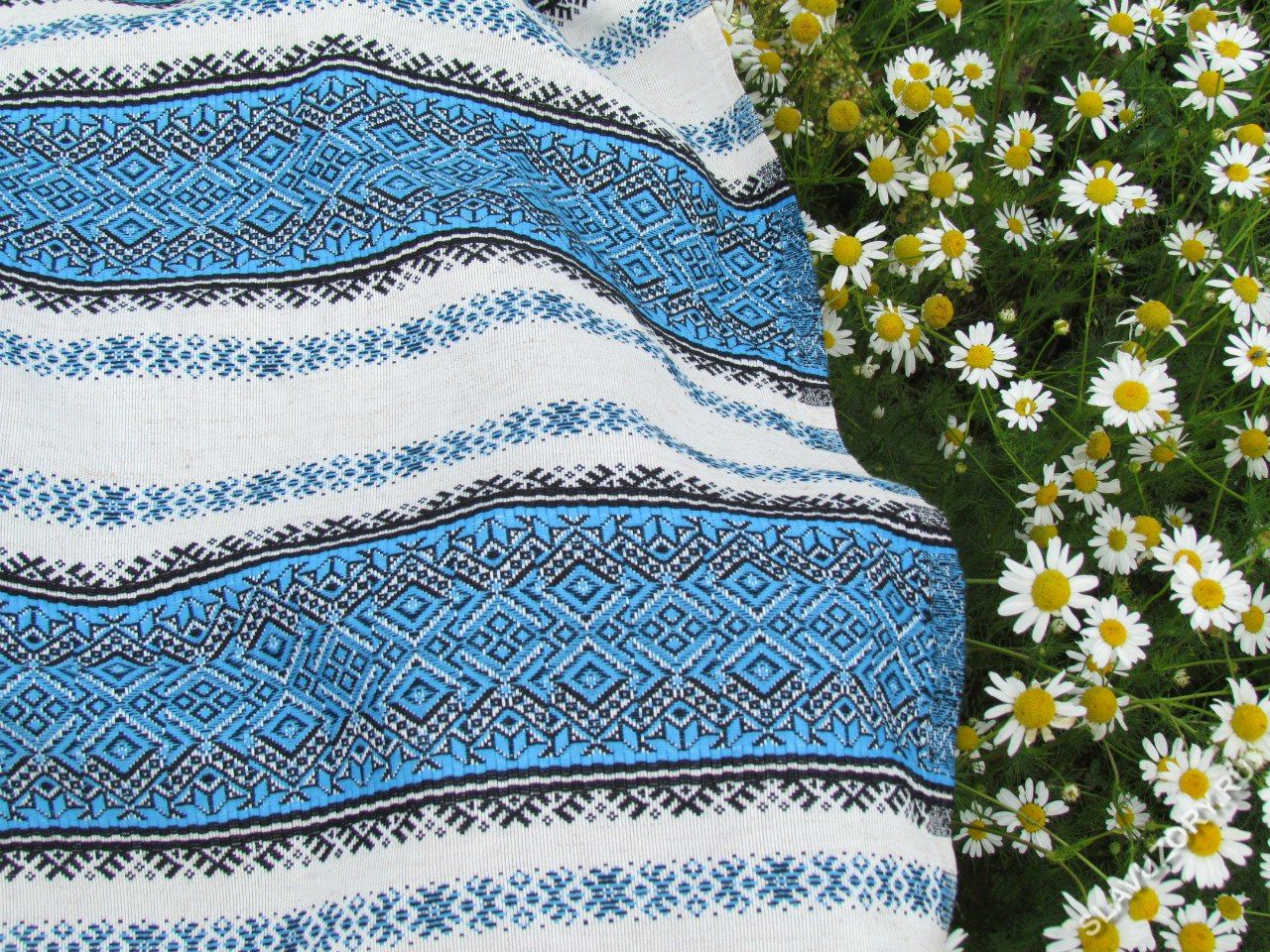
Embroidery has long been loved in all corners of the world.
This is a real distinctive decor.

Embroidery is a very interesting, although time-consuming exercise, which, like any creative activity, must be given in full
With its help you can decorate not only clothes, but also home textiles, create unique accessories.

Embroidery is an important participant in building space and creating an atmosphere in a house.
Today many craftswomen, creating a decor, regard work only as creativity.
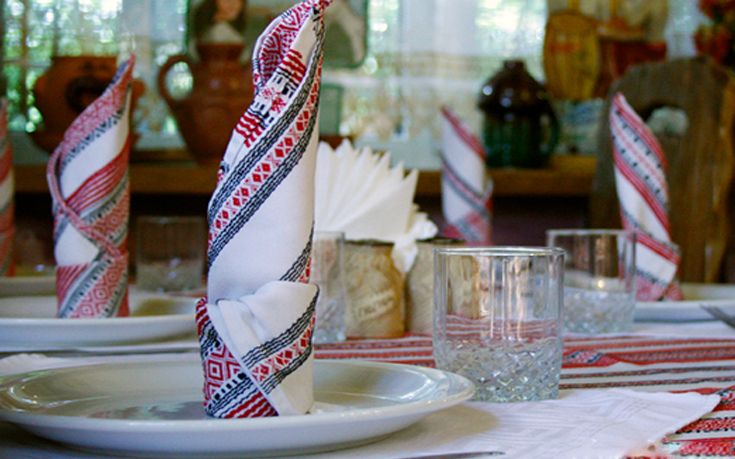
Interior items, decorated with embroidery, give not only individuality to housing, but also fill it with warmth
But our ancestors believed that embroidery, namely, each of its elements, is symbolic.
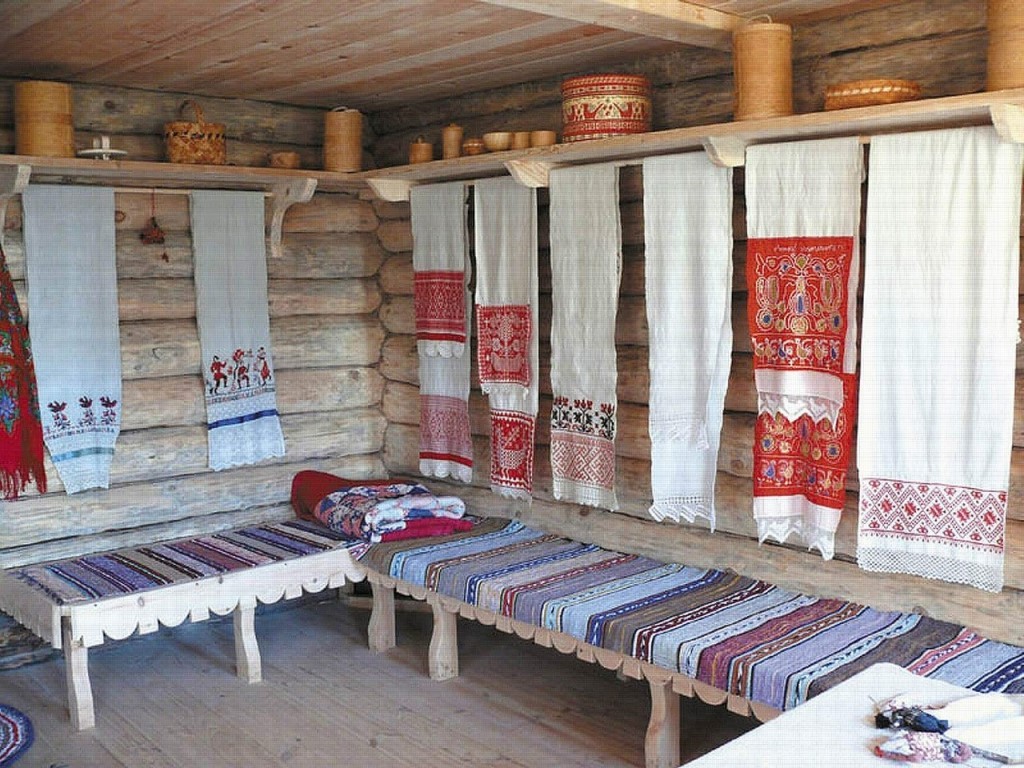
Among the many types of Russian folk art, embroidery has always occupied an important place.
Whole paintings were not only decor, but also a valuable family amulet.
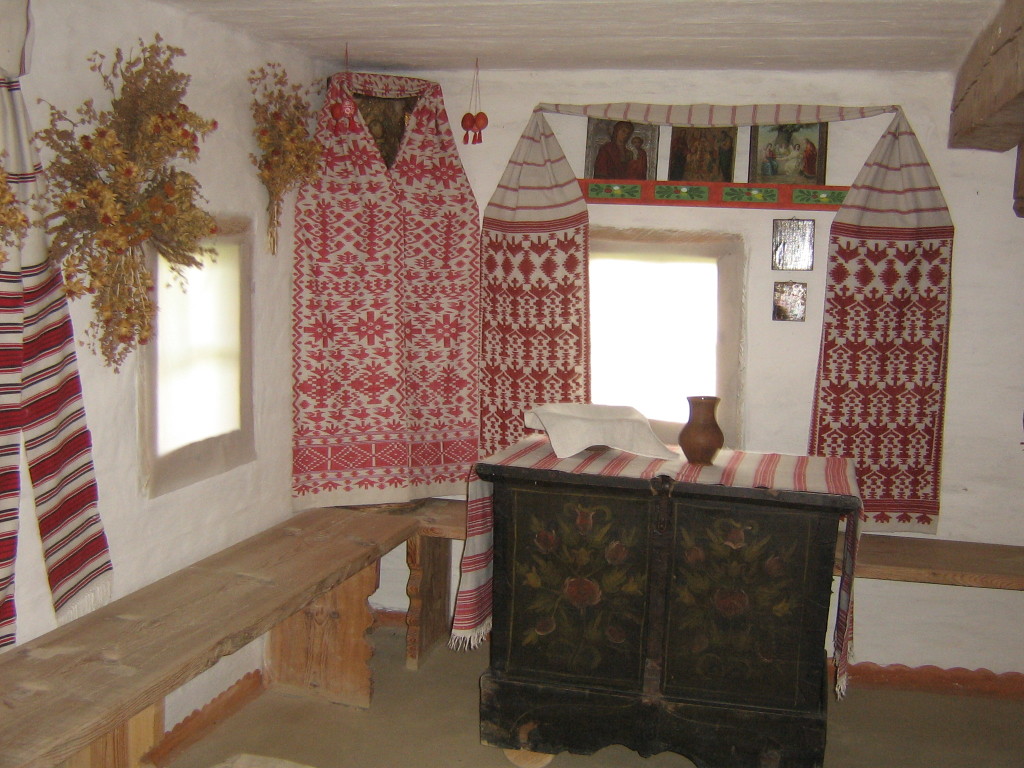
For several centuries, the Slavic people developed certain techniques of embroidery performance, the nature of the ornament and its color.
Mother prepared the dowry for her daughter with her own hands. It was believed that when embroidering clothes, tablecloths, or bedding, she endowed her with special properties that protect against the evil eye, envious ones, diseases, and filth.
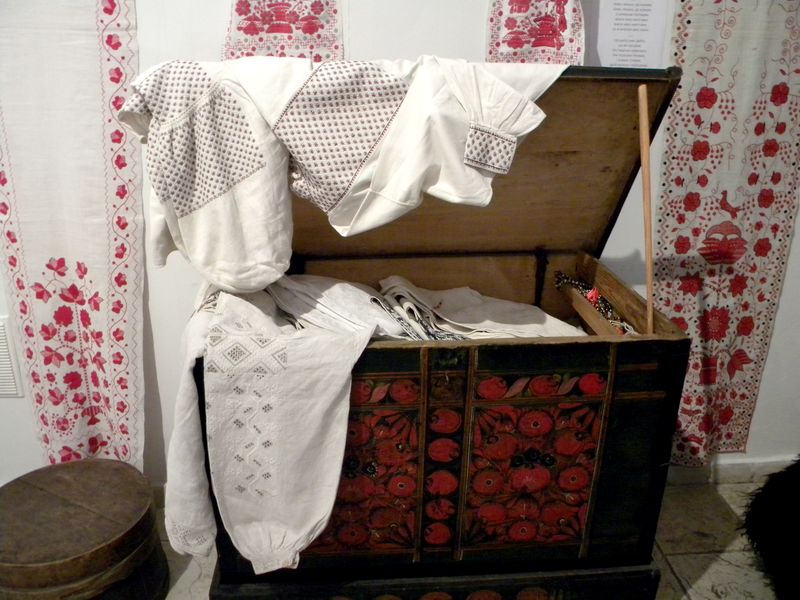
Chest of dowry for the bride

According to the ancient traditions of the Russian wedding, the bride’s dowry consisted of many different things that began to be collected long before the wedding
Coastal ornaments or patterns were not chosen randomly. Each individual color, combination of shades, symbols and interlacing in the patterns had their magical meaning, designed to protect from harm and bring well-being to the house. Also important was the location of the picture.
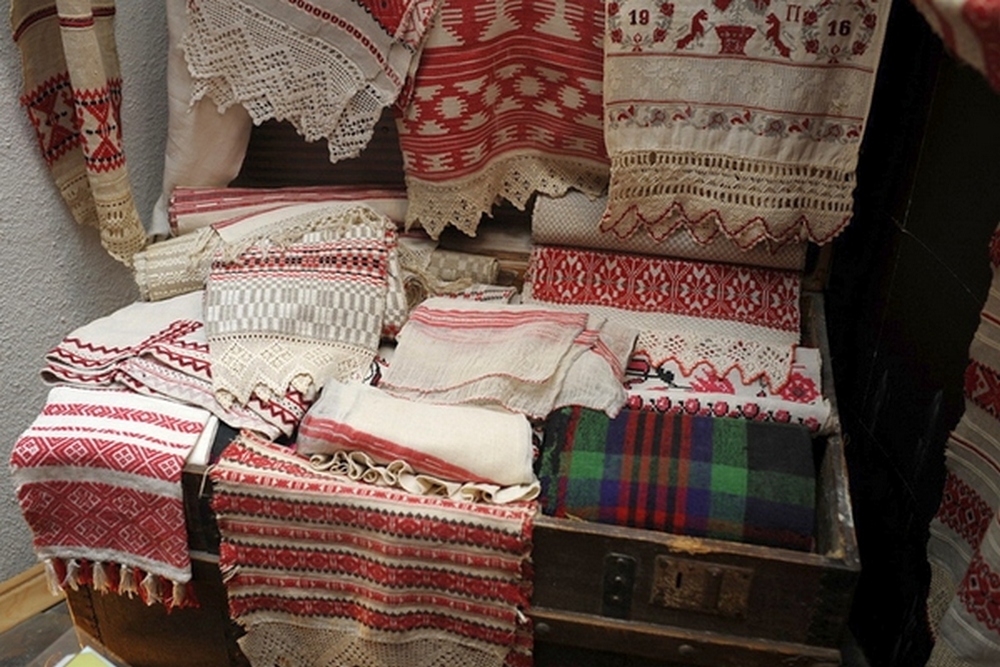
In the past, the size of the dowry largely determined the popularity of the bride
Today there are schemes, thanks to which you can decorate the interior, accessories, jewelry, clothes, create whole masterpieces, both in cross stitch technique and in satin stitch.

Beautiful and original modern products, decorated with Ukrainian folk embroidery.
Before choosing patterns, ornaments and patterns for embroidery, remember that this is not just a decor.

Patterns appeared simultaneously with the first shoots of art and culture.
Each symbol and their combination carries one or another meaning. The most popular elements and combinations are as follows:
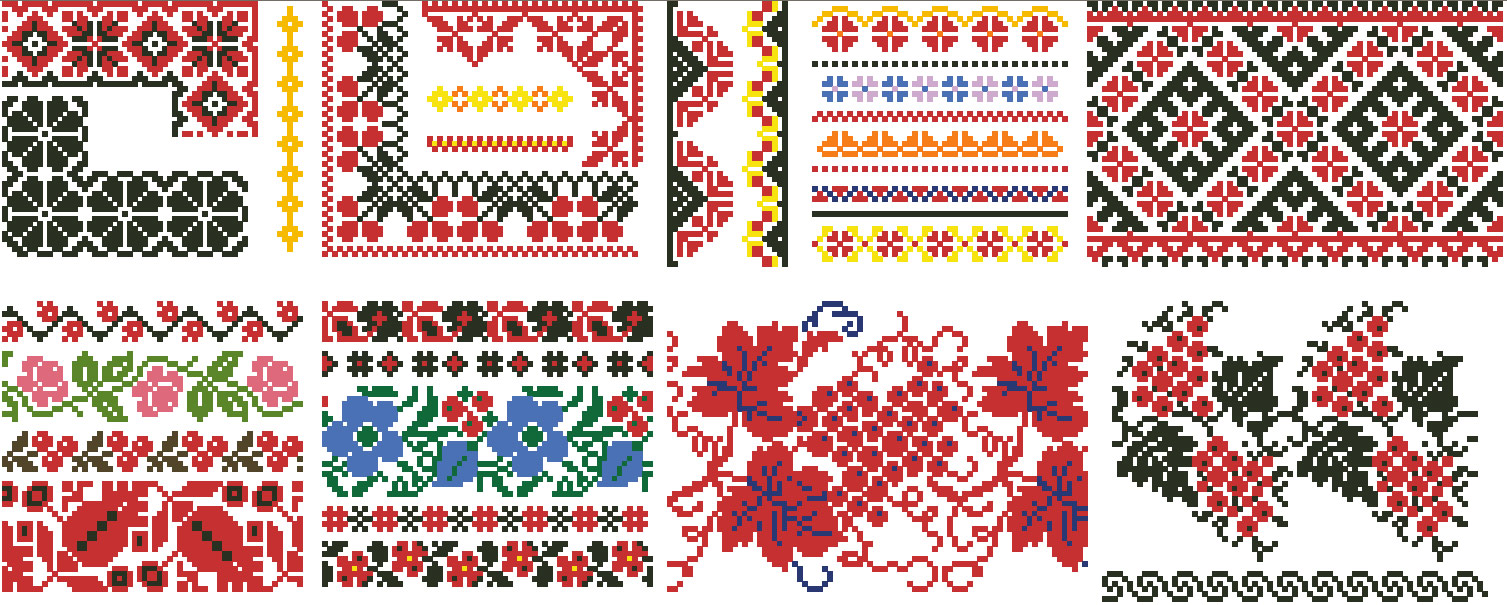
A collection of floral and geometric patterns for embroidery.
There is a strict rule: embroidery-charm should be performed without knots. So she will not break the connection with her carrier!
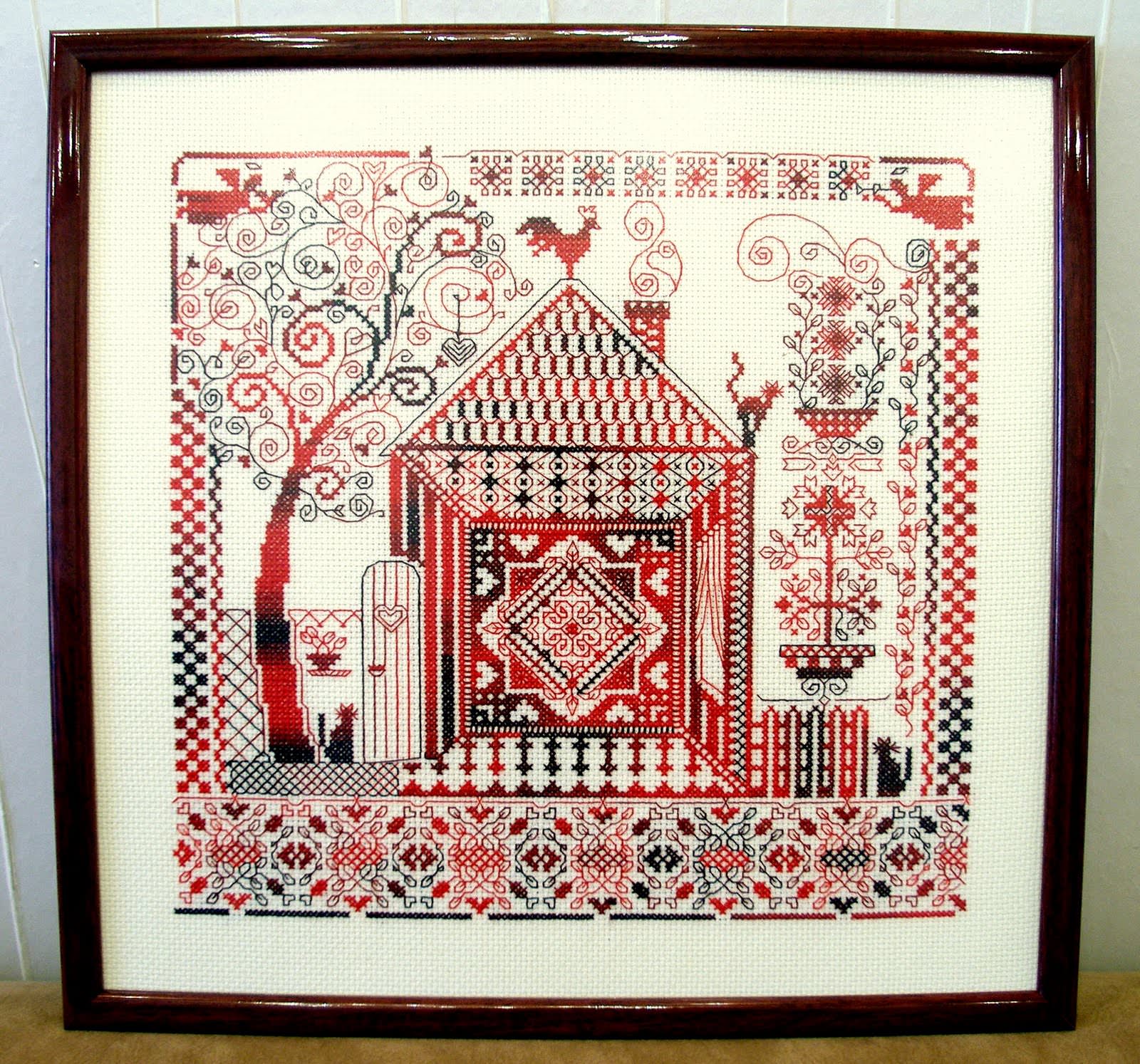
Embroidery "Charm of the hearth"
It was believed that the cross-stitch embroidered the prayer and became the strongest talisman for the person.
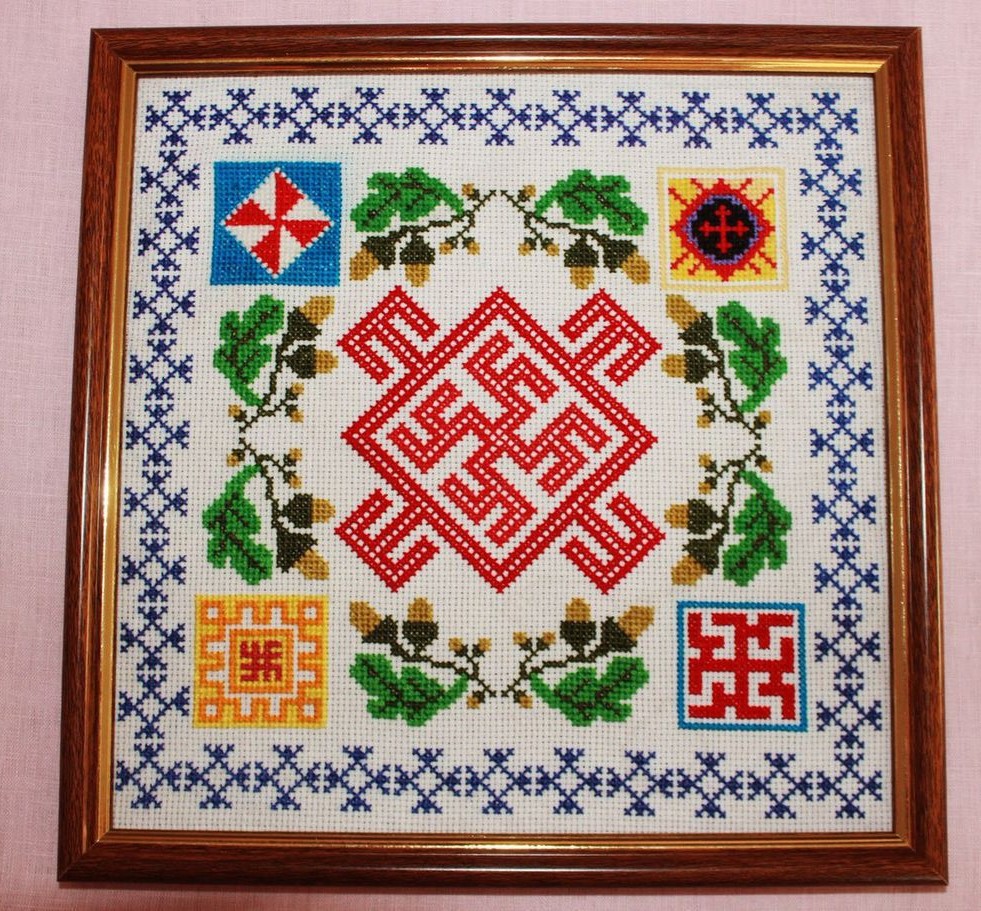
Embroidery "Charm for men"
Such handicraft still bears a riddle today, since each of its elements also has a symbolic meaning:
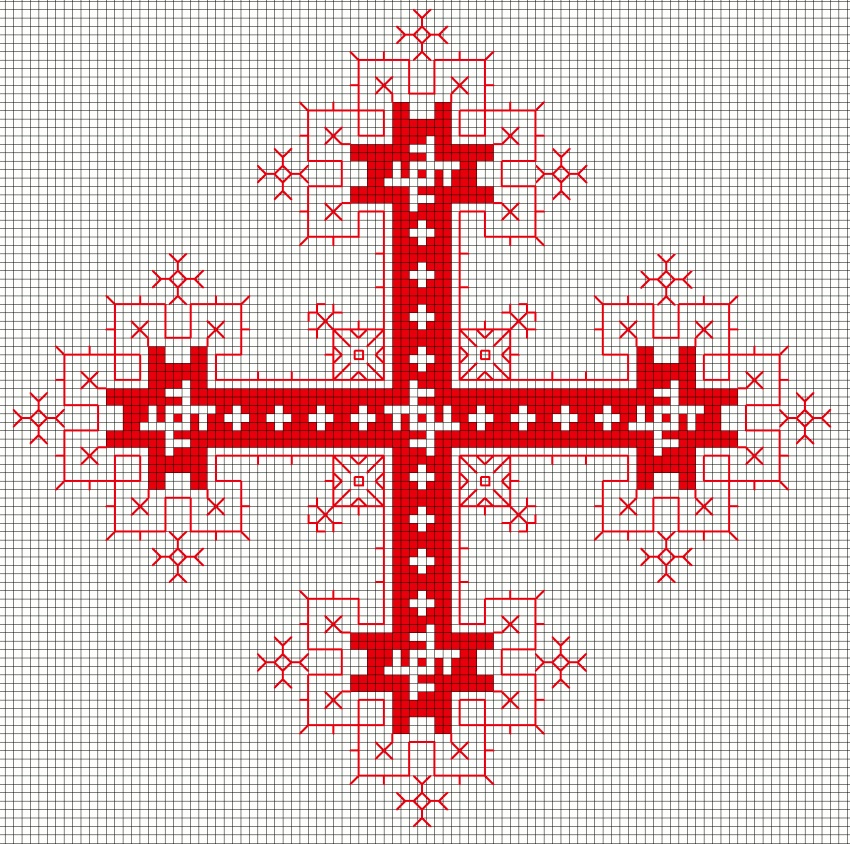
Cross
![]()
Svarga
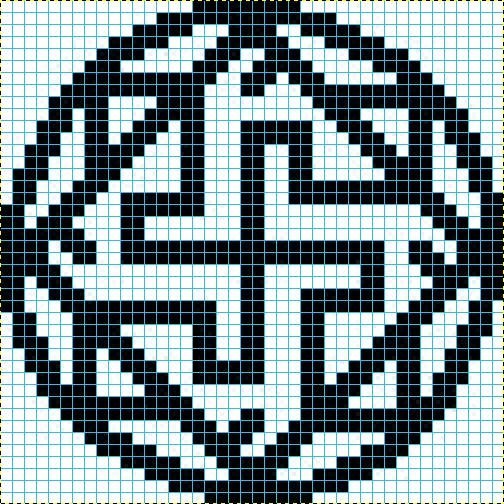
A circle

Ruzha
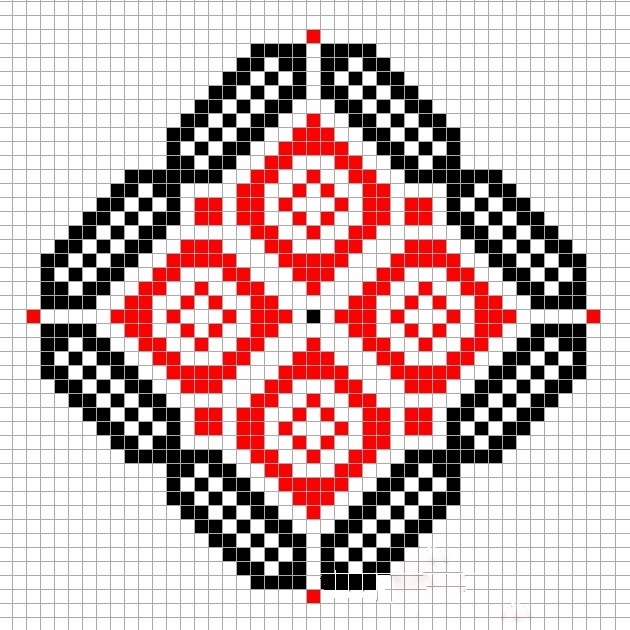
Diamond Ornament
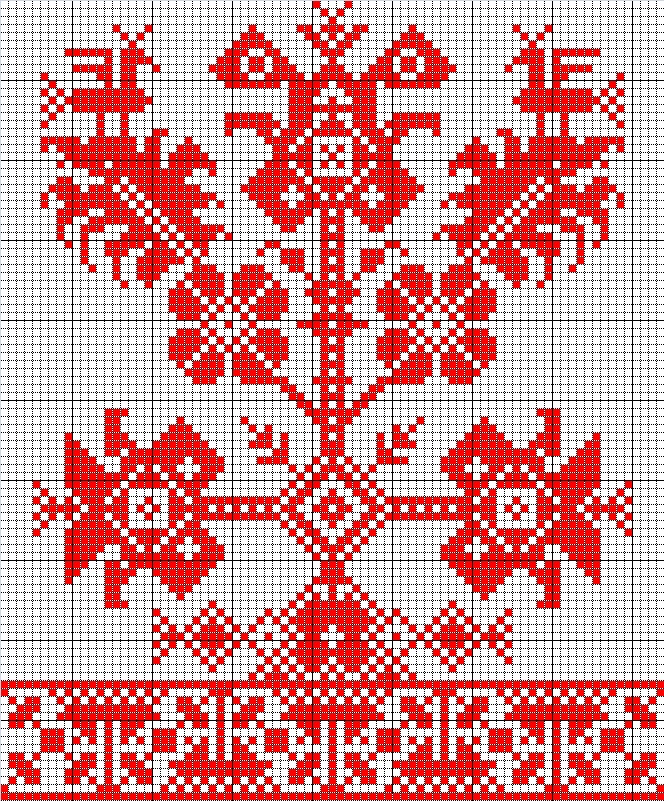
Tree of Life
These are not all the symbols and motifs that make up the ethnic patterns and embroidery patterns. If they are present in the embroidered product, it means that it has the great power of the amulet.
Today, in retail outlets, shops, or on the vast expanses of the Internet, you can find ready-made décor, as well as a variety of patterns for embroidery or knitting, with your own hands to create a decor for something. About how to make embroidery with your own hands, you can read
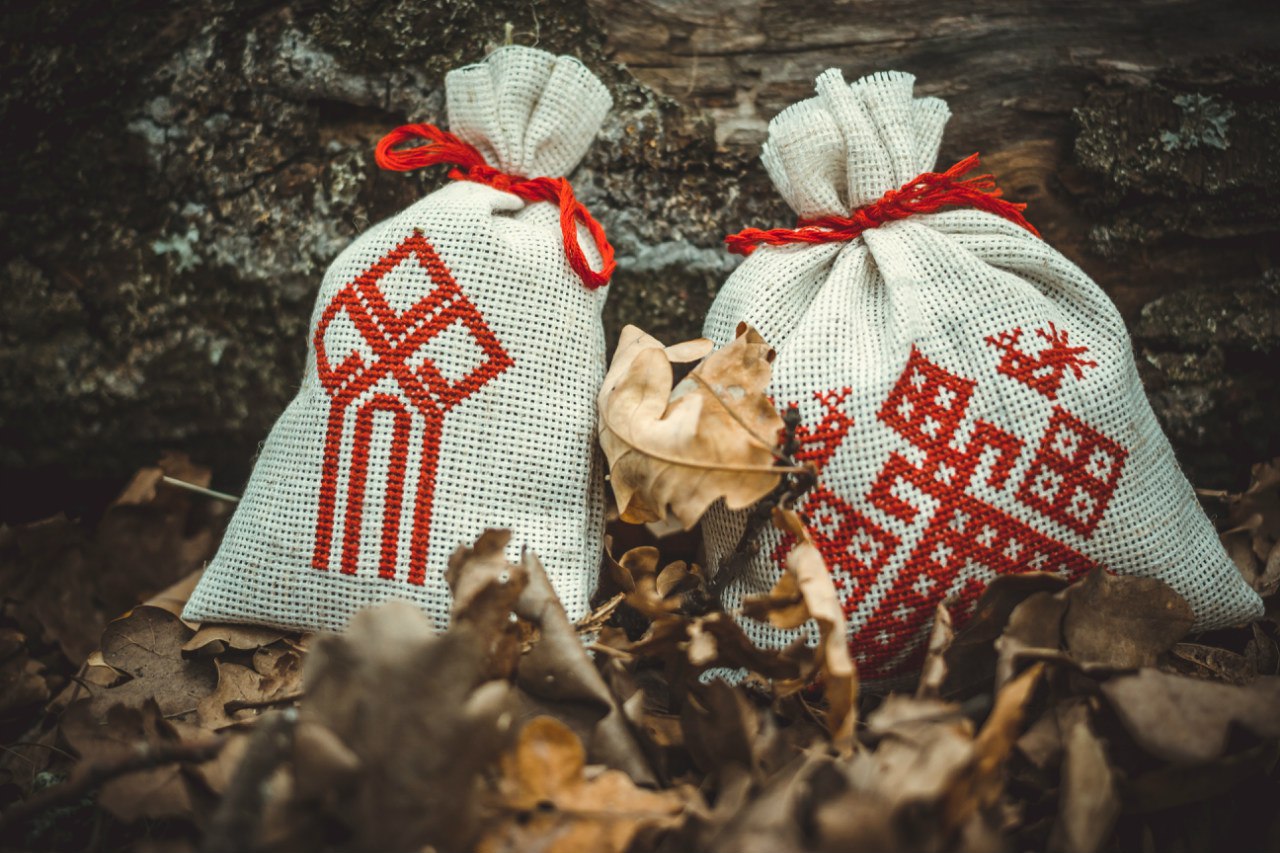
Decorative bags with embroidery
The most popular are:
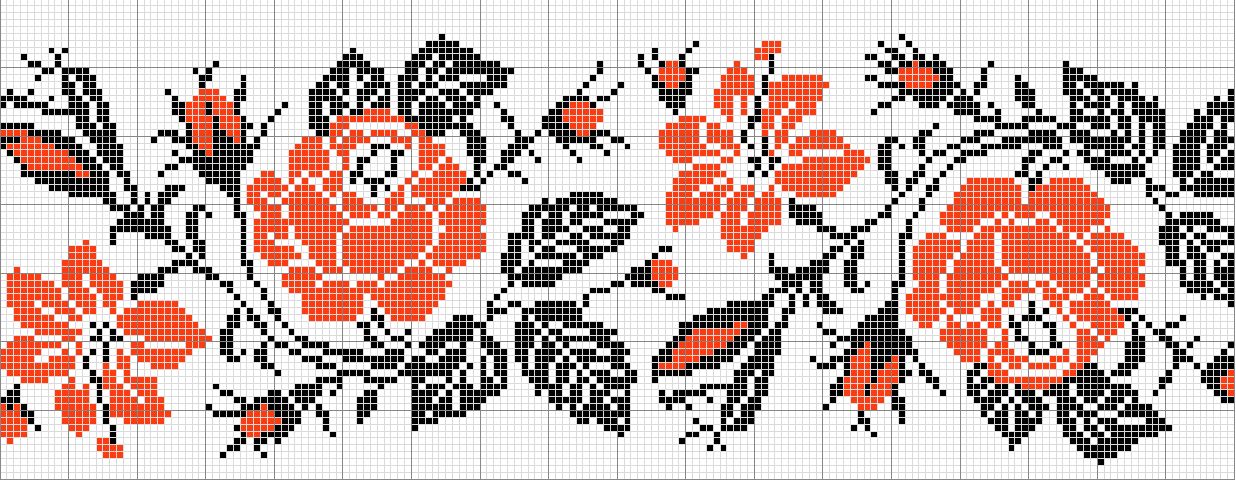
For embroidery you will need a cross-stitch fabric, threads of the desired color, a hoop. Before starting work, it is necessary to determine the number of cells in width and length, mark them with a pencil and prepare an outline. For convenience, you can mark every 10 cells. Next, stretched the canvas on the hoop and proceed to embroidery.
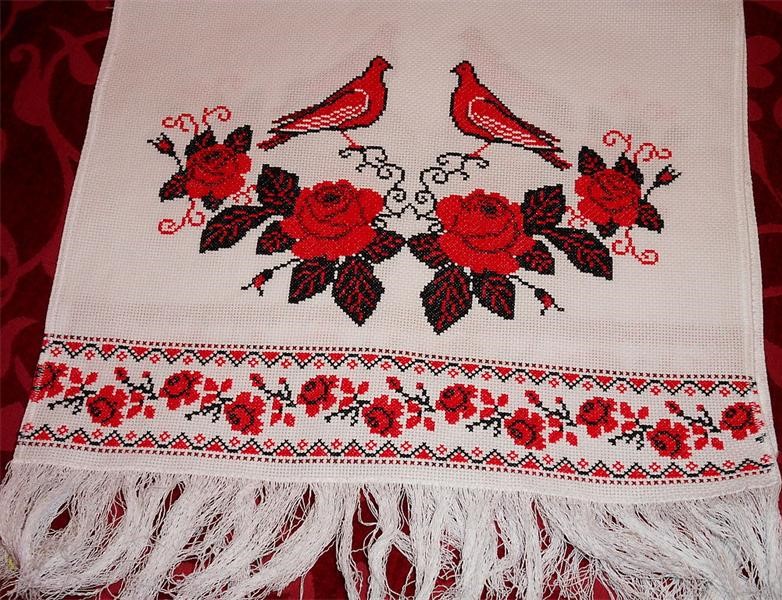

The scheme for embroidery monochrome heart
Before embroidery is marking on the fabric1 0x10 for convenience. Embroidery is made in two threads from top to bottom. Do not leave knots, the edges of the thread are closed with stitches (crosses). The thread is attached to the front side, the stitches can be vertical or horizontal. The scheme is as follows: first, the required number of diagonal stitches in one direction is performed, and then we move in the opposite direction in the same way. It is important to monitor the accuracy on the seamy side, because the fabric is thin, and irregularities and flaws can appear through.
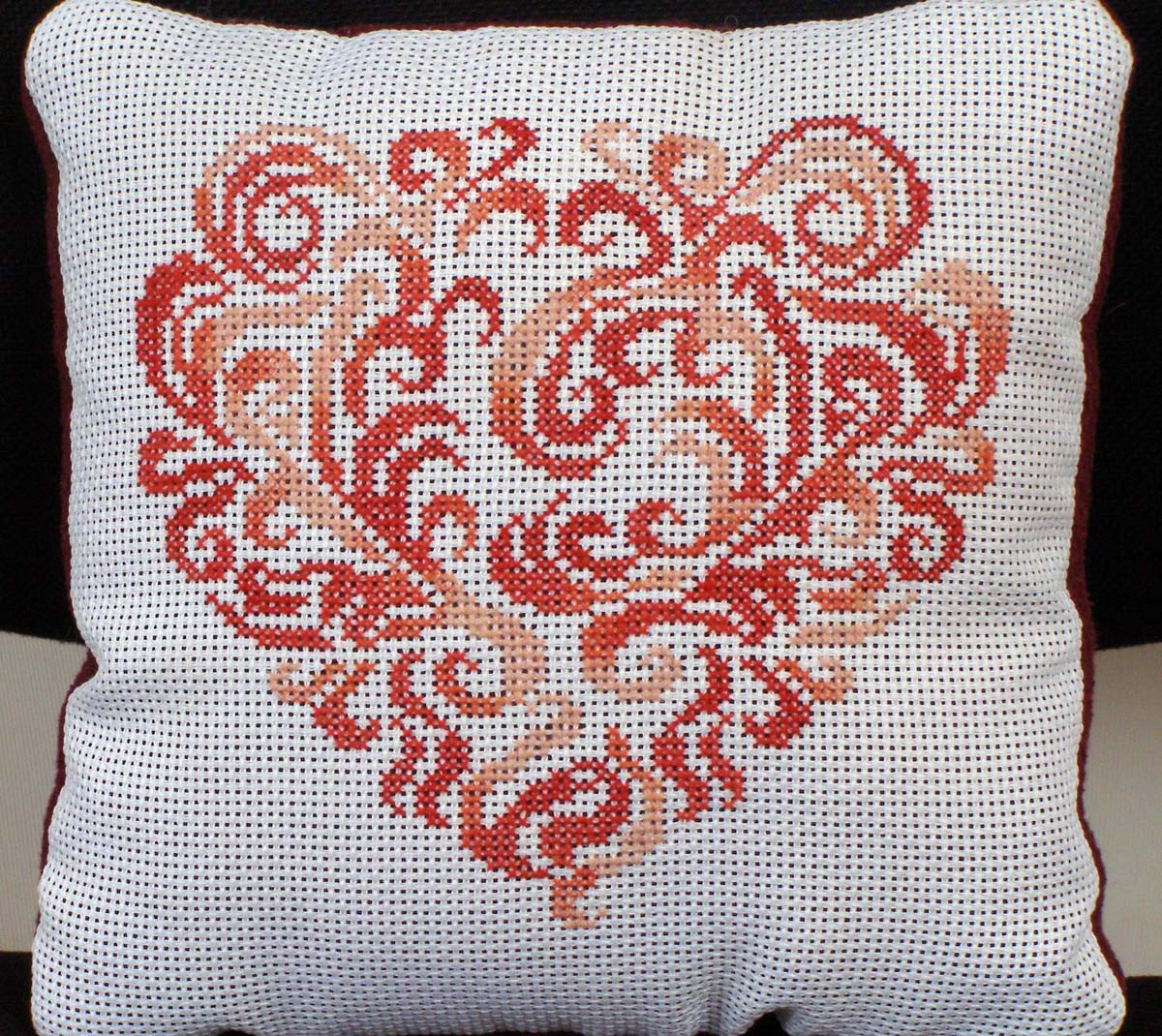
Heart-shaped pillow decorated with monochrome embroidery

Norwegian snowflake pattern
Lazy jacquard pattern is done with knitting. When knitting one row, threads of two or more colors are used. The pattern in the Scandinavian ethnic style is knitted with a satin stitch using countable patterns that illustrate the wrong side and the front side. The front row is considered from right to left, purl - from left to right. When knitting is used the main and additional thread, so all the loops are not tightened broaches.
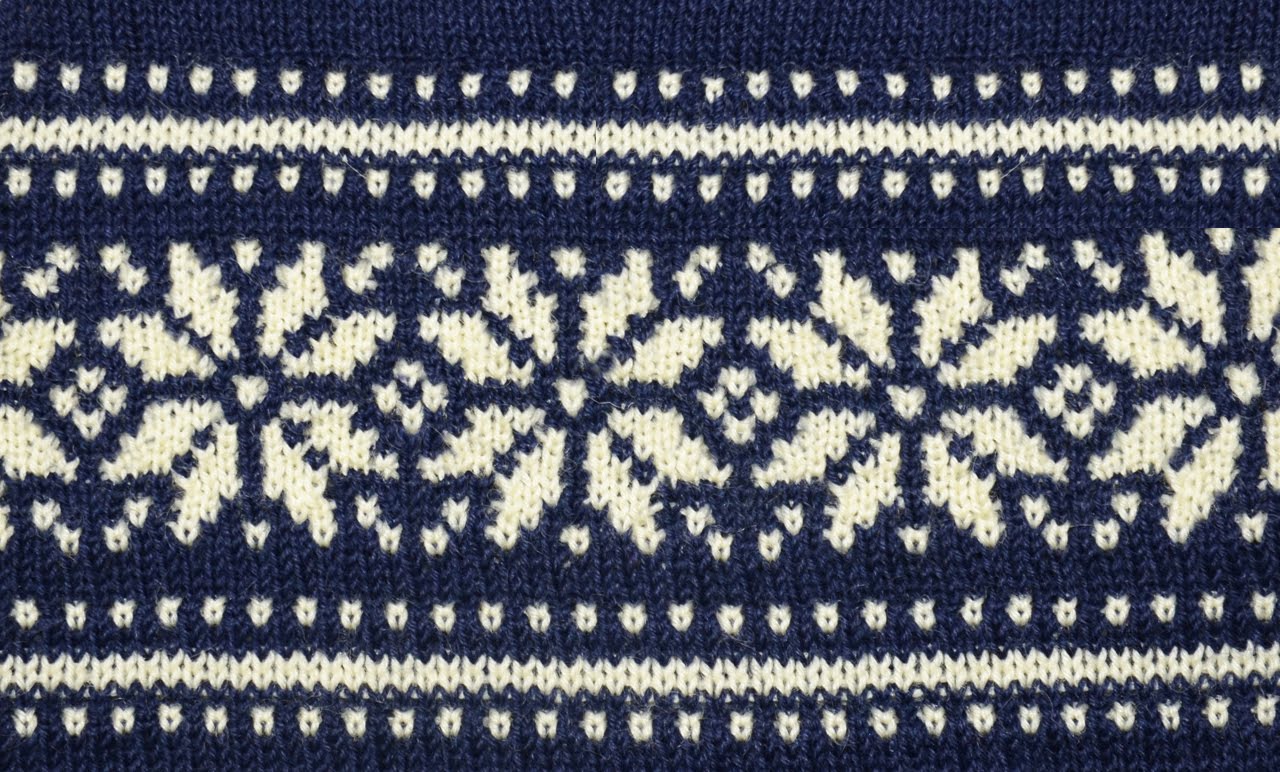
On the basis of "lazy jacquard" you can create interesting things in the ethnic Scandinavian style.
Today you can find a variety of patterns for knitting or embroidery in ethnic style. Such a national ornament, geometric patterns or floral motifs can decorate any piece of clothing or textile accessory in the interior. Authentic ethnic motifs are always outside the fashion trends. This is a classic and creative in one bottle, originality and tribute to folk culture.
Jacquard without broaches
Cross-stitch
| Related articles: | |
|
Korean carrot grater
Carrots, cooked long ago fell in love with our man. She learned ... Where and how to exchange bitcoin for rubles in Russia
Today, many people who play on cryptocurrency exchanges and engaged in ... Ornaments of the peoples of the world: styles, motifs, patterns
One of the newest fashion trends in the world of nail art - nails decorated with ... | |